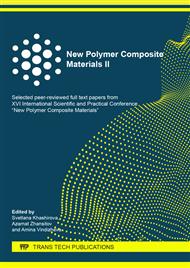[1]
V.E. Mizonov, Modeling, calculation and optimization of heat and mass transfer processes in the textile industry: monograph, Ivanovo, (2010).
Google Scholar
[2]
S.V. Ershov, E.N. Kalinin, Synthesis of a cell model of mass transfer in the process of fibrous material dewatering by distributed pressure, Izvestiya Vysshikh Uchebnykh Zavedenii, Seriya Teknologiya Tekstil'noi Promyshlennosti. 6 (2011) 118-121.
Google Scholar
[3]
S.V. Ershov, E.N. Kalinin, The use of mechanical vibrations as a factor in the intensification of mass transfer processes in the technology of processing capillary-porous structures. Dynamics of machines and working processes: a collection of materials of the All-Russian Scientific and Technical Conference, Chelyabinsk, 2012. pp.96-98.
Google Scholar
[4]
S.V. Ershov, E.N. Kalinin, The method of cell modeling as a tool for the numerical analysis of mass transfer during the dewatering of textile material in a roll pair. Current Trends in the Development of Information Technologies in Textile Science and Practice: A Collection of Materials of the All-Russian Scientific and Technical Conference, Dimitrovgrad, 2012. pp.14-18.
Google Scholar
[5]
N.E. Novikov, Pressing the paper web, Moscow, (1972).
Google Scholar
[6]
V.P. Fandeev, K.S. Samokhina, Methods for the study of porous structures – access mode. https://naukovedenie.ru/PDF/34TVN415.pdf/.
Google Scholar
[7]
S.A. Koksharov, N.L. Kornilova, S.V. Fedosov, Modification of polyester fiber to create composite materials with adjustable stiffness, Izvestiya Vysshikh Uchebnykh Zavedenii, Seriya Khimiya i Khim. Tekhnologiya. 59 (2016) 105-111.
DOI: 10.6060/tcct.20165906.5364k
Google Scholar
[8]
A. Schiavi, L. Shtrepi, D. Corona, Effective scale of microstructure of fibrous permeable materials. ICSV25, Hiroshima, 8-12 July (2018).
Google Scholar
[9]
S.V. Aleeva, et al., Specificity of changes in the sorption capacity of flax fiber with controlled biocatalizable destruction of neutral polycarbohydrates, Izvestiya Vysshikh Uchebnykh Zavedenii, Seriya Khimiya i Khim. Tekhnologiya. 61 (2018) 80-85.
DOI: 10.6060/tcct.20186102.5512
Google Scholar
[10]
S. Ershov, E. Kalinin, Cell modeling of mass transfer in a dewatering process of fiber by distributed pressure, Тechical Transactions 5/2017 Mechanics year., Cracow University of technoiogy, (Chemical Abstracts). 114 (2017) 123-128.
Google Scholar
[11]
Pat. No. 2435992 Russian Federation, IPC F15B 21/12, B06B 1/18. A device for creating a pulsed loading regime of executive bodies of technological machines.
Google Scholar


